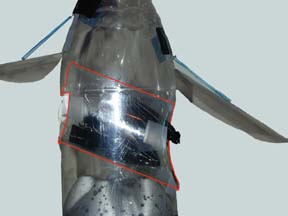This is an idea for a parachute deployment method that may have some merit. Due to the rainy Texas weather it remains untested as of 6-12-00. This is called the Parachute Tube. Here is a brief description: A tube is cut from a 24oz Pepsi bottle. The tube is cut from the bottle right where the flare starts. This gives a small lip that will protrude past the edge of the nose section. This is important because the chute wants to hang on any little snag. The lip ensures there is a smooth path out the door. The tube is inserted into a guppied 2 liter nosecone at an angle. An upper and lower "air speed flap" door are fashioned. These flaps are the brainchild of ______ _________. I used flaps cut from the same area on a bottle as they were going to cover to help get the curves to match so the doors would lay flat. I also put several rubber bands over the nosecone around the doors and left them overnight to help form the doors to the nosecone profile. The small chute is attached to the nosecone section with a screw eye and small fishing line swivel. The hooks for the rubber bands and hinges are little pieces of PET, bent and taped on. I used light weight rubber bands, trying for a balance between springing open and staying closed when a puff of air was applied. 
|



